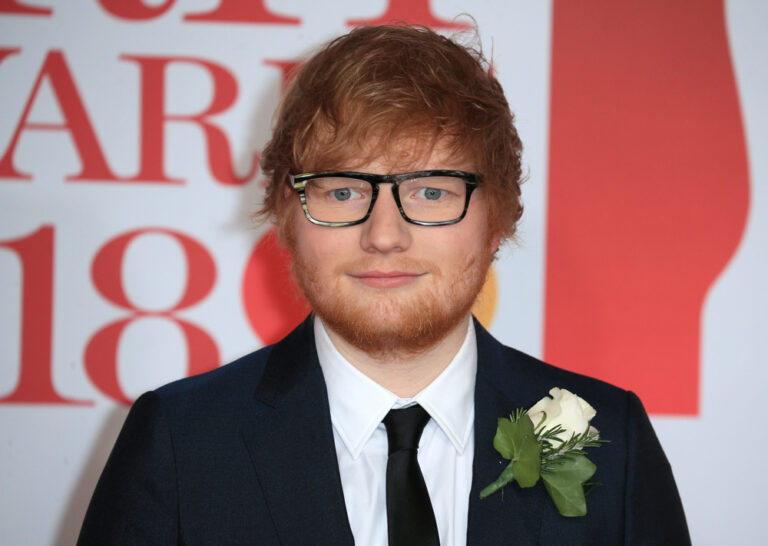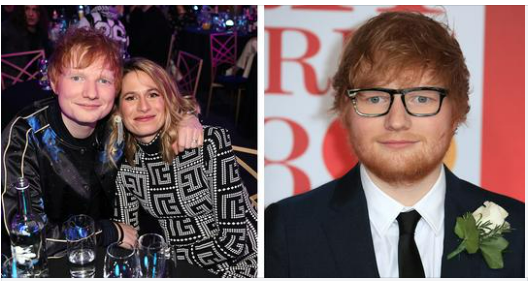It’s sometimes easy to forget that celebrities, for all their riches and star power, are the same as the rest of us. As a result, they’re subject to the same joys and sorrows, the same heartbreaks and shocks and tough times in life.
Perhaps we would do well to remember that the next time we’re jumping into sensationalistic headlines and believing rumors that crop up without any evidence. Celebrities are people too, and challenging periods come for them as well.
Don’t believe us? You need only look as far as Ed Sheeran, whose wife was cruelly diagnosed with cancer last year while pregnant with the couple’s second child.
He’s known worldwide as one of the most successful music artists of his genration, but Ed Sheeran’s had more than his fair share of worry in the last couple of years.
As per reports, he and wife Cherry Seaborn have been married since 2019, having initially gotten together in 2015.
Yet their worlds were turned upside down last year when Cherry was diagnosed with cancer while pregnant. Compounding Sheeran’s sense of woe was the fact that his best friend died that same month.

Speaking in his Disney+ docu-series Ed Sheeran: The Sum of It All, Sheeran explained: “Cherry’s health, it was really bad, and then suddenly my best friend Jamal dies.
“You guys said, ‘Do you want to make a documentary?’ And I went, ‘Yeah, it should be me in the studio and we’ll play the gig.
“That’s not what the documentary is.”
The camera than cuts to Sheeran in floods of tears as he travels in the back of a car.
Sheeran’s wife Cherry revealed in the same documentary that doctors discovered a tumor in her arm during the sixth month of her pregnancy.
“I got diagnosed with cancer at the start of the year….,” she said. “It made me massively reflect on our mortality. I would never agree to do anything like this, but it made me think, ‘Oh if I died, what’s people’s perception of me? What do you leave behind?’”
She continued: “For Ed, the whole point is he wants to say to people, ‘I’m not just this music machine. I’m not just this robot that tries to get No. 1. I’m a father, I’m a son, I’m a friend.’ It wasn’t until this year when I was like, ‘I might die.’”

Following months of worry, Cherry successfully delivered she and her husband’s second child. She underwent successful surgery to address the tumor in her arm shortly thereafter.
We can’t begin to imagine the worry that must have gripped Ed Sheeran upon learning his wife had a tumor while pregnant. Thank God everything turned out okay.
Couple found something that they thought was a common stone – at closer look, they realized its true value

Valuable items can occasionally be seen but remain hidden. While out for a stroll, a couple saw what they initially believed to be a rock. Upon closer examination, it was revealed to be something quite else.
Discover what incredible discovery they made by continuing to read.
Overton, Lancashire residents Gary and Angela Williams were taking it easy on the beach when they noticed something completely out of the ordinary. They came upon what they initially believed to be a common rock while strolling along Middleton Sands Beach in the United Kingdom. However, upon closer inspection, they discovered it to be something quite different.
Intrigued, they noticed something that had washed up on the beach. They chose to examine it more closely. At first, the pair believed it looked like an egg from a dinosaur or something prehistoric. Intrigued, they made the decision to learn more.
https://googleads.g.doubleclick.net/pagead/ads?gdpr=0&client=ca-pub-3764810839868565&output=html&h=183&slotname=8851483697&adk=1469159098&adf=1228460536&pi=t.ma~as.8851483697&w=730&fwrn=4&lmt=1712066137&rafmt=11&format=730×183&url=https%3A%2F%2Favokaddo.com%2F2024%2F03%2F20%2Fcouple-found-something-that-they-thought-was-a-common-stone-at-closer-look-they-realized-its-true-value%2F%3Ffbclid%3DIwAR21cjntzxa0FsFZz-1QTV-LPtvM2MZzAkCP5bBQ3kIMDyba5KCiKnKdYVE_aem_ASCnvfPJ_kwlynMXL2wz-h9F_Ra3Dq7Lgcdr0AA0vMnJfUeqHdJdaH2tmGEffgMaNn4zTMI8piM1X3LQF59rT04T&wgl=1&uach=WyJXaW5kb3dzIiwiMTUuMC4wIiwieDg2IiwiIiwiMTA3LjAuNTA0NS43OSIsbnVsbCwwLG51bGwsIjY0IixbWyJOb3QgQShCcmFuZCIsIjk5LjAuMC4wIl0sWyJPcGVyYSBHWCIsIjEwNy4wLjUwNDUuNzkiXSxbIkNocm9taXVtIiwiMTIxLjAuNjE2Ny4xODYiXV0sMF0.&dt=1712066103084&bpp=1&bdt=2622&idt=1001&shv=r20240327&mjsv=m202403270101&ptt=9&saldr=aa&abxe=1&cookie=ID%3Df147c99c20c808c3%3AT%3D1712066104%3ART%3D1712066104%3AS%3DALNI_MbQZUwQS3t0vftqDd4WKRBPSJTsXA&gpic=UID%3D00000d7f4a617f97%3AT%3D1712066104%3ART%3D1712066104%3AS%3DALNI_MbzMvSAPCegAX7SMHsAaJTXS-Ucww&eo_id_str=ID%3Df2c4ebfb6f5bdfb3%3AT%3D1712066104%3ART%3D1712066104%3AS%3DAA-AfjaMLQ-U9c0_dsSktLq-Pz3c&prev_fmts=0x0%2C1100x280%2C1481x762%2C730x183&nras=2&correlator=5546171324948&frm=20&pv=1&ga_vid=1330846553.1712066103&ga_sid=1712066104&ga_hid=494653614&ga_fc=1&rplot=4&u_tz=420&u_his=1&u_h=864&u_w=1536&u_ah=864&u_aw=1536&u_cd=24&u_sd=1.25&dmc=8&adx=190&ady=1790&biw=1481&bih=762&scr_x=0&scr_y=0&eid=44759875%2C44759926%2C44759842%2C42531706%2C44795922%2C31082332%2C95322183%2C95328825&oid=2&pvsid=4055703272845522&tmod=405680396&uas=0&nvt=1&ref=https%3A%2F%2Fl.facebook.com%2F&fc=1920&brdim=0%2C0%2C0%2C0%2C1536%2C0%2C0%2C0%2C1495%2C762&vis=1&rsz=%7C%7CopeEbr%7C&abl=CS&pfx=0&fu=128&bc=31&bz=0&psd=W251bGwsbnVsbCxudWxsLDNd&ifi=4&uci=a!4&btvi=2&fsb=1&dtd=34058

Their curiosity paid off, as they chose to examine the object in further detail. They had inadvertently discovered ambergris, a material that is extremely valuable.
https://googleads.g.doubleclick.net/pagead/ads?gdpr=0&client=ca-pub-3764810839868565&output=html&h=183&slotname=3197500636&adk=788230268&adf=3241251536&pi=t.ma~as.3197500636&w=730&fwrn=4&lmt=1712066137&rafmt=11&format=730×183&url=https%3A%2F%2Favokaddo.com%2F2024%2F03%2F20%2Fcouple-found-something-that-they-thought-was-a-common-stone-at-closer-look-they-realized-its-true-value%2F%3Ffbclid%3DIwAR21cjntzxa0FsFZz-1QTV-LPtvM2MZzAkCP5bBQ3kIMDyba5KCiKnKdYVE_aem_ASCnvfPJ_kwlynMXL2wz-h9F_Ra3Dq7Lgcdr0AA0vMnJfUeqHdJdaH2tmGEffgMaNn4zTMI8piM1X3LQF59rT04T&wgl=1&uach=WyJXaW5kb3dzIiwiMTUuMC4wIiwieDg2IiwiIiwiMTA3LjAuNTA0NS43OSIsbnVsbCwwLG51bGwsIjY0IixbWyJOb3QgQShCcmFuZCIsIjk5LjAuMC4wIl0sWyJPcGVyYSBHWCIsIjEwNy4wLjUwNDUuNzkiXSxbIkNocm9taXVtIiwiMTIxLjAuNjE2Ny4xODYiXV0sMF0.&dt=1712066103085&bpp=1&bdt=2622&idt=1000&shv=r20240327&mjsv=m202403270101&ptt=9&saldr=aa&abxe=1&cookie=ID%3Df147c99c20c808c3%3AT%3D1712066104%3ART%3D1712066104%3AS%3DALNI_MbQZUwQS3t0vftqDd4WKRBPSJTsXA&gpic=UID%3D00000d7f4a617f97%3AT%3D1712066104%3ART%3D1712066104%3AS%3DALNI_MbzMvSAPCegAX7SMHsAaJTXS-Ucww&eo_id_str=ID%3Df2c4ebfb6f5bdfb3%3AT%3D1712066104%3ART%3D1712066104%3AS%3DAA-AfjaMLQ-U9c0_dsSktLq-Pz3c&prev_fmts=0x0%2C1100x280%2C1481x762%2C730x183%2C730x183&nras=2&correlator=5546171324948&frm=20&pv=1&ga_vid=1330846553.1712066103&ga_sid=1712066104&ga_hid=494653614&ga_fc=1&rplot=4&u_tz=420&u_his=1&u_h=864&u_w=1536&u_ah=864&u_aw=1536&u_cd=24&u_sd=1.25&dmc=8&adx=190&ady=2603&biw=1481&bih=762&scr_x=0&scr_y=0&eid=44759875%2C44759926%2C44759842%2C42531706%2C44795922%2C31082332%2C95322183%2C95328825&oid=2&pvsid=4055703272845522&tmod=405680396&uas=0&nvt=1&ref=https%3A%2F%2Fl.facebook.com%2F&fc=1920&brdim=0%2C0%2C0%2C0%2C1536%2C0%2C0%2C0%2C1495%2C762&vis=1&rsz=%7C%7CopeEbr%7C&abl=CS&pfx=0&fu=128&bc=31&bz=0&psd=W251bGwsbnVsbCxudWxsLDNd&ifi=5&uci=a!5&btvi=3&fsb=1&dtd=34073
https://googleads.g.doubleclick.net/pagead/ads?gdpr=0&client=ca-pub-3764810839868565&output=html&h=183&slotname=2267562348&adk=159546671&adf=384721286&pi=t.ma~as.2267562348&w=730&fwrn=4&lmt=1712066137&rafmt=11&format=730×183&url=https%3A%2F%2Favokaddo.com%2F2024%2F03%2F20%2Fcouple-found-something-that-they-thought-was-a-common-stone-at-closer-look-they-realized-its-true-value%2F%3Ffbclid%3DIwAR21cjntzxa0FsFZz-1QTV-LPtvM2MZzAkCP5bBQ3kIMDyba5KCiKnKdYVE_aem_ASCnvfPJ_kwlynMXL2wz-h9F_Ra3Dq7Lgcdr0AA0vMnJfUeqHdJdaH2tmGEffgMaNn4zTMI8piM1X3LQF59rT04T&wgl=1&uach=WyJXaW5kb3dzIiwiMTUuMC4wIiwieDg2IiwiIiwiMTA3LjAuNTA0NS43OSIsbnVsbCwwLG51bGwsIjY0IixbWyJOb3QgQShCcmFuZCIsIjk5LjAuMC4wIl0sWyJPcGVyYSBHWCIsIjEwNy4wLjUwNDUuNzkiXSxbIkNocm9taXVtIiwiMTIxLjAuNjE2Ny4xODYiXV0sMF0.&dt=1712066103086&bpp=1&bdt=2624&idt=1690&shv=r20240327&mjsv=m202403270101&ptt=9&saldr=aa&abxe=1&cookie=ID%3Df147c99c20c808c3%3AT%3D1712066104%3ART%3D1712066104%3AS%3DALNI_MbQZUwQS3t0vftqDd4WKRBPSJTsXA&gpic=UID%3D00000d7f4a617f97%3AT%3D1712066104%3ART%3D1712066104%3AS%3DALNI_MbzMvSAPCegAX7SMHsAaJTXS-Ucww&eo_id_str=ID%3Df2c4ebfb6f5bdfb3%3AT%3D1712066104%3ART%3D1712066104%3AS%3DAA-AfjaMLQ-U9c0_dsSktLq-Pz3c&prev_fmts=0x0%2C1100x280%2C1481x762%2C730x183%2C730x183%2C730x183&nras=2&correlator=5546171324948&frm=20&pv=1&ga_vid=1330846553.1712066103&ga_sid=1712066104&ga_hid=494653614&ga_fc=1&rplot=4&u_tz=420&u_his=1&u_h=864&u_w=1536&u_ah=864&u_aw=1536&u_cd=24&u_sd=1.25&dmc=8&adx=190&ady=2810&biw=1481&bih=762&scr_x=0&scr_y=0&eid=44759875%2C44759926%2C44759842%2C42531706%2C44795922%2C31082332%2C95322183%2C95328825&oid=2&pvsid=4055703272845522&tmod=405680396&uas=0&nvt=1&ref=https%3A%2F%2Fl.facebook.com%2F&fc=1920&brdim=0%2C0%2C0%2C0%2C1536%2C0%2C0%2C0%2C1495%2C762&vis=1&rsz=%7C%7CopeEbr%7C&abl=CS&pfx=0&fu=128&bc=31&bz=0&psd=W251bGwsbnVsbCxudWxsLDNd&ifi=6&uci=a!6&btvi=4&fsb=1&dtd=34079
It smelled bad, but at first they thought it looked interesting. The material is highly valuable in terms of money. In the perfume industry, it is highly sought after and is a key fixative in many upscale, luxury perfumes.
The digestive tract of sperm whales forms ambergris when they swallow sharp things, such as the beaks of squid, which is one of their favorite foods. To prevent damage to the intestinal lining, the whale’s intestines release a sticky material that encapsulates these foreign things. These accumulated leftovers gradually harden into lumps of different sizes and are sent out through regurgitation or feces. This mixture turns into a solid product with a particular aromatic scent when exposed to sunshine and seawater, according to specialists.

The chunk of Ambergris they found smelled strongly like wax and had a waxy feel. Gary said it smelled like fish and organic fertilizers. Despite its unappealing appearance, the material was extremely valuable.
The quantity they discovered was 1.5 kg, and they calculated its estimated value to be $70,000! However, as ambergris is frequently connected to the illicit activity of whaling, possessing it is prohibited in some nations.
See the tale of a family who discovered unexpected buried gems underneath.
Who would have guessed that an odd-looking “rock” could be so valuable? Because life might throw you for a loop, it’s always a good idea to be interested. Talk to your friends and relatives about this amazing story.



Leave a Reply